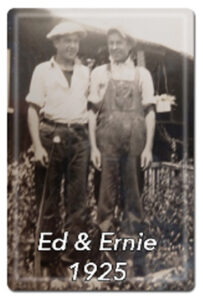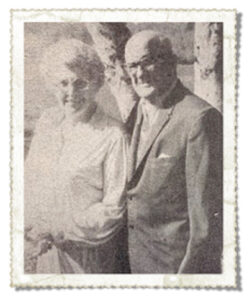ED TATOM
Oral History Project
Ed and his uncle were more than grateful to be rescued the following morning. They hadn’t brought many provisions on board and had only 1 small can of Dinty Moore’s stew remaining. Desperate for drinking water, they had resorted to melting ice scraped from the tuna in their holding tank.
 Ed Tatom and his twin brother (Ernie) were born in 1908 in Florence. The house once stood behind the shops now lining Bay Street. Their parents were Emma and Dr. William Edward Tatom, the first Florence resident dentist. In addition to his practice in town, Dr. Tatom made dentistry rounds by horseback or horse drawn buggy. He serviced folks in the towns of Newport, Kernville, Siletz, and Elk City. According to Ed, his father’s practice “didn’t get much in those days”. His going rate to extract a tooth was 50 cents. He filled teeth as well. Along his route Indians also sought his services. They met him on the trail, and sat on a tree stump while Dr. Tatom performed the necessary dental work. At times, travelling such a route would require him to be away from Florence for up to 3 weeks. Ed knew people who claimed to still be using the dental plates his father made for them 30 years before.
Ed Tatom and his twin brother (Ernie) were born in 1908 in Florence. The house once stood behind the shops now lining Bay Street. Their parents were Emma and Dr. William Edward Tatom, the first Florence resident dentist. In addition to his practice in town, Dr. Tatom made dentistry rounds by horseback or horse drawn buggy. He serviced folks in the towns of Newport, Kernville, Siletz, and Elk City. According to Ed, his father’s practice “didn’t get much in those days”. His going rate to extract a tooth was 50 cents. He filled teeth as well. Along his route Indians also sought his services. They met him on the trail, and sat on a tree stump while Dr. Tatom performed the necessary dental work. At times, travelling such a route would require him to be away from Florence for up to 3 weeks. Ed knew people who claimed to still be using the dental plates his father made for them 30 years before.
Ed Tatom went on to have a successful career as the Police Chief for Florence (3 years) and Newport (10 years). This story however, covers the portions of his life prior to and following his law enforcement years.
A DAY IN THE LIFE OF ED TATOM
Ed attended school through the 8th grade. During the fishing season, after school each day he and his older brother Willie worked at the Kyle Cannery. Their job was to label salmon cans. His love of boats may have been inherited, as his mother’s family spent much of their lives at sea. By the time he was 16, Ed’s first job aboard a boat was that of a mess boy. From there he worked as a commercial fisherman on steam schooners and cargo ships which primarily transported lumber. Some of those boats included the Daisy Freeman, an old double-end schooner; and the Jean Neddleton, an old Coos Bay schooner. He also worked on the Robert Johnson, a 4-masted schooner.
One could say luck was with Ed throughout his life, as he managed to escape near death situations several times. While working on boats early in his career, he was swept overboard more than once but managed to swim to shore each time. On another occasion, he experienced what could have been a devastating situation. He was commercial fishing on a tuna boat with his uncle, as he often did. Intending to be a day trip, they started early and loaded the holding tanks with ice for their anticipated catch. They were about 100 miles out of Newport after catching a fair share of tuna when they encountered engine trouble. They drifted for days, with no radio. It wasn’t until the third day when Ed spotted a ship in the distant horizon. He quickly climbed up the boat’s rigging and frantically waved his white hat to capture the ship’s attention. The ship was an enormous oil tanker that managed to change course, approach their boat, and radio the Coast Guard. Ed and his uncle were more than grateful to be rescued the following morning. They hadn’t brought many provisions on board and had only 1 small can of Dinty Moore’s stew remaining. Desperate for drinking water, they had resorted to melting ice scraped from the tuna in their holding tank.
Despite having work opportunities for adventure on extended boat trips, Ed preferred the coastal trips closer to home. The furthest north he chose to go was the Columbia River, then south to San Pedro and San Diego. In 1929 he was aboard the Tiwane, a Hanlon schooner carrying freight from Coos Bay to the Saubert fish plant at Cushman. They transported rock salt for salmon cure, groceries to the Kyle, R.C. Dunham and Cushman stores. Drums of gasoline were also part of the cargo. For a while he worked on the Old Colonel P.S. Mitchie (Mikey), a government dredging vessel.
Regardless of a typical hard day’s work, people often resorted to walking as their means of recreation. Ed’s uncle and cousins lived in Newport and he enjoyed visiting with them for a few days. In order to get there, he and his brother Ernie would walk from Florence to Newport along the beach. When asked how long such a journey would take, he replied ‘it took us about two days’.
 Ed met and began courting Alma Holden while she was in high school. They married in 1931. He paid $10 for a house and floated it down the river from the Cushman railroad bridge. They set the house on 2 lots on Chestnut Street and began raising a family.
Ed met and began courting Alma Holden while she was in high school. They married in 1931. He paid $10 for a house and floated it down the river from the Cushman railroad bridge. They set the house on 2 lots on Chestnut Street and began raising a family.
In 1935, he worked for 18 months building the Siuslaw Bridge as part of the WPA (Works Progress Administration) project. He earned $1.50 a day. One day while working on the bridge, Ed fell into the river. He swam to shore, went home for a change of clothing then returned to work that same day. During World War II he also worked on the bridge as a guard.
Throughout his life, Ed respected and knew the value of hard work. He was also keen on trying the unusual, and even wrestled bears for charity (more than once!).
FAILING EYESIGHT
It was in Canada that Ed experienced a serious life changing experience. In 1964 he worked as a fire lookout for the British Columbia Forest Service. He and Alma enjoyed life there, but after a few years Ed’s eyesight began to fail. In time, Ed lost all sight to total blindness. He remained blind for 5 months before undergoing a procedure in Florida, where miraculously, his eyesight was restored. They returned to Florence and settled in the Sutton Lake area. In 1973, they returned to live on Alma’s family farm up the North Fork of the Siuslaw River.
Ed Tatom contributed to the history of Florence through his lifestyle of fishing, logging and public service. He was an active member of the North Fork Grange, serving as Grange Master from 1980 to 1983. A strong Grange advocate, he helped bring educational and social programs to farmers and those living in rural areas. He promoted farm production and addressed issues and concerns surrounding the daily lives of its members. His was a life well lived.
